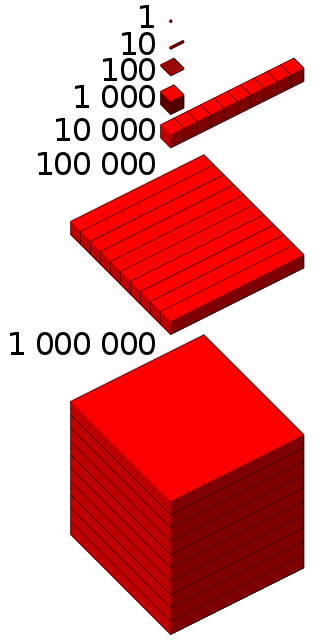
In number theory, a perfect number is a positive integer that is equal to the sum of its positive divisors, excluding the number itself. For instance, 6 has divisors 1, 2 and 3, and 1 + 2 + 3 = 6, so 6 is a perfect number.

In mathematics, parity is the property of an integer of whether it is even or odd. An integer is even if it is a multiple of two, and odd if it is not. For example, −4, 0, 82 are even because
10 (ten) is the even natural number following 9 and preceding 11. Ten is the base of the decimal numeral system, by far the most common system of denoting numbers in both spoken and written language. It is the first double-digit number. The reason for the choice of ten is assumed to be that humans have ten fingers (digits).

In mathematics, a square number or perfect square is an integer that is the square of an integer; in other words, it is the product of some integer with itself. For example, 9 is a square number, since it equals 32 and can be written as 3 × 3.

In mathematics, a multiply perfect number is a generalization of a perfect number.
28 (twenty-eight) is the natural number following 27 and preceding 29.
72 (seventy-two) is the natural number following 71 and preceding 73. It is half a gross or 6 dozen.

120, read as one hundred [and] twenty, is the natural number following 119 and preceding 121.
1000 or one thousand is the natural number following 999 and preceding 1001. In most English-speaking countries, it can be written with or without a comma or sometimes a period separating the thousands digit: 1,000.
In mathematics, a harmonic divisor number, or Ore number, is a positive integer whose divisors have a harmonic mean that is an integer. The first few harmonic divisor numbers are:
2000 is a natural number following 1999 and preceding 2001.

A hexagonal number is a figurate number. The nth hexagonal number hn is the number of distinct dots in a pattern of dots consisting of the outlines of regular hexagons with sides up to n dots, when the hexagons are overlaid so that they share one vertex.
8000 is the natural number following 7999 and preceding 8001.
The Green–Schwarz mechanism is the main discovery that started the first superstring revolution in superstring theory.
8128 is the integer following 8127 and preceding 8129.

One million (1,000,000), or one thousand thousand, is the natural number following 999,999 and preceding 1,000,001. The word is derived from the early Italian millione, from mille, "thousand", plus the augmentative suffix -one.
100,000 (one hundred thousand) is the natural number following 99,999 and preceding 100,001. In scientific notation, it is written as 105.

In number theory, a polite number is a positive integer that can be written as the sum of two or more consecutive positive integers. A positive integer which is not polite is called impolite. The impolite numbers are exactly the powers of two, and the polite numbers are the natural numbers that are not powers of two.
Superstring theory is an attempt to explain all of the particles and fundamental forces of nature in one theory by modeling them as vibrations of tiny supersymmetric strings.







